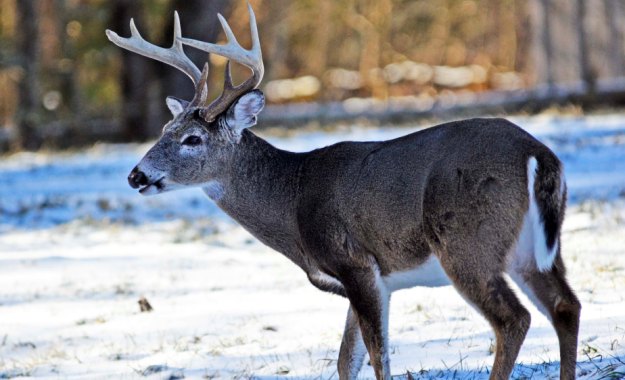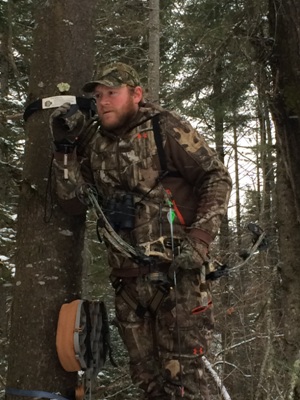Brent Lafreniere Says Hunting Deer in Vermont Isn’t Easy

Editor’s Note: Brent Lafreniere lives in Williamstown, Vermont, and has been a Vermont resident his entire life. He’s been a Mossy Oak Pro Staffer for 6 years, has hunted deer for 25 years and hunts primarily public lands. “I’m a real fan of Mossy Oak Bottomland, but in the newer patterns I like Mossy Oak Break-Up Infinity because I can use it not only for deer season but also for turkey season.” Because of winter deer kill and loss of habitat, the area where Lafreniere hunts is a really-difficult place to see or take deer. However, while hunting for 21 seasons in Vermont, Lafreniere has taken 19 deer. Because he’s such an avid hunter, he also travels to other states where deer season is open when Vermont’s season is closed, and where he can see and take more deer.
Tough winters and a loss of habitat really have impacted the deer population in Vermont. Vermont used to be a major dairy farm state, however, in recent years many of the dairy farms have gone out of business. Much of those farmlands have grown into mature forests, and our state doesn’t produce as much grain and hay as it once did. In some areas, urban sprawl has eaten up much of the deer and turkey habitat. Although I hunt both private and public lands, the majority of my hunting is on public lands.
Our archery season starts the first Saturday in October and continues until the last Sunday in October. Our rifle season starts the second Saturday in November and runs for 2 weeks, usually until the first Sunday after Thanksgiving. Our muzzleloader season begins the following Saturday and runs until the following Saturday; but hunters can hunt with either muzzleloaders or bows then. Although I think deer season will change in 2016, in the past, we’ve been allowed to take three deer in one calendar year with two of those bucks. You can take one buck and two does or harvest three does during archery season; but then you can’t hunt during the rifle, muzzleloader or late bow season. During rifle and muzzleloader season, we only can take one antlered buck. We have an antler restriction that says you only can harvest bucks with at least one branched antler. During blackpowder season, we have a lottery for taking antlerless deer. To hunt all three seasons, I hunt with a bow, a muzzleloader and a rifle. During 2016, a new regulation states that any hunter over 50 years old can hunt with a crossbow during archery season.
 In the region where I grew up, there was a state forest that was very mountainous with mostly hardwoods. Our deer population there wasn’t nearly as large as it was in lower elevations. We have a state forest named Camel’s Hump, which is the name of the mountain that’s within that forest. I started deer hunting when I was 12 and took my first deer with a firearm in 2007 when I was 23. I’d taken deer with my bow before then, but that was the year I took my first rifle buck. I was able to track that buck in the snow to his bed.
In the region where I grew up, there was a state forest that was very mountainous with mostly hardwoods. Our deer population there wasn’t nearly as large as it was in lower elevations. We have a state forest named Camel’s Hump, which is the name of the mountain that’s within that forest. I started deer hunting when I was 12 and took my first deer with a firearm in 2007 when I was 23. I’d taken deer with my bow before then, but that was the year I took my first rifle buck. I was able to track that buck in the snow to his bed.
Snow tracking is a common practice that we use here in Vermont to find and take deer. One time I discovered three sets of tracks in the snow, with two of those tracks headed up the mountain where I planned to hunt. The other tracks went down the mountain. I really didn’t want to go down the mountain, but I decided I could follow that track down the mountain, and that the buck might be bedded down close by. This hunt took place 2 years after the state had imposed the antler restriction. I followed the tracks for about 200 yards and came to a fallen tree. I moved slowly and quietly and spotted the buck bedded-down. I could see he was a legal buck and had a forked horn. We’d had 3-4 inches of snow the prior evening, and that’s the reason I could move so quietly. The buck was only 20 to 30 yards from me, looking away from me. I raised my rifle and took the shot. The buck only traveled about 30 yards before he went down. I called my cousin, and he came and helped me drag the buck out.
We didn’t much snow in 2015. However, any year we have snow, snow tracking can be a very-effective way to find and take whitetails, especially if you hunt the day after a new snow when the tracks are fresh. Too, that’s when the deer don’t usually travel as far before they bed down. The snow also allows you to see further into the woods and covers the leaves, making stalking much easier, since the deer don’t hear you coming. This technique works well in mountainous country where I once hunted. When I got on a track, if the deer went over the mountain, often I could peek over the edge of the ridge and see the deer before they could spot me. Vermont primarily has three types of deer hunters: sitters, walkers and drivers. Since I don’t really have the patience to sit still, unless I’m in a tree stand, I prefer to walk (stalk) deer. I’ve been fortunate enough to take four deer using this snow tracking tactic.
Tomorrow: Learning about Brent Lafreniere’s Biggest Vermont Buck



























